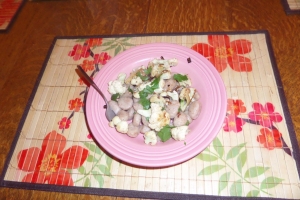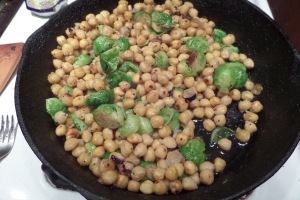
Either vegan or with a dusting of Parmesan, Midweek Mushroom and Orzo is wholesome, delectable and quick enough for a midweek dinner.
Okay, for those of you who can tell time, I actually finished the challenge at the beginning of the week with a gigantic vegetable splurge at Calafia, a restaurant that caters to pretty much any kind of finicky eater. The splurge was delicious, a plate of cauliflower puree, roasted beets, garbanzo beans, kale, broccolini and probably a couple of other things. Perfectly balanced as far as color, taste and texture went. And if I weren’t doing the vegan challenge, I would never have ordered it. (I’d have been too busy salivating over the duck pizza.)
Which is, perhaps, the real point of doing this sort of thing–to change old habits, and remember just how wonderful something like a cauliflower can be. Yes, I thoroughly enjoyed the fresh cinnamon roll I had the next day, but I was able to eat it mindfully rather than as something I craved because my blood sugar had been skyrocketing up and down.
As a result, when I hit the farmer’s market the next morning, I, well, thought like a vegan–what vegetable was going to be the basis of dinner? When I saw a $3 box of some sort of local white mushroom (oyster?), I simply grabbed it.
Once at home, I promptly got out my little bag of dried mushrooms and set about making stock. I love mushroom stock–it is so insanely simply and reliable. I mean, take two pieces of dried mushroom, some onion, carrot and a tough celery rib. Add water, simmer for 20 minutes and you’re good to go. If that’s too much effort, you can get a basic stock simply by soaking that same dried mushroom in hot water.
Once the stock was done, it was simple of matter of waiting ’til near dinner and then trying out some whole-wheat orzo I’d picked up, combining with sauteed mushrooms and onions, adding the stock and cooking like rice for 20 minutes.
While I found most whole-wheat pasta a bit mealy, whole-wheat orzo didn’t have that problem–the small size of each piece, perhaps, keeps it from being that way. The mushrooms worked well with the heavier flavors of the whole-wheat pasta. I did allow myself a little grated parmesan–just to remind myself I wasn’t a vegan–but it wasn’t really necessary.
As an added bonus, the next day I zapped the leftovers in the microwave for lunch–it was excellent as, I suspect, it would be at room temperature. It’s also cheap, convenient and matches up nicely with a green salad, which is my lazy vegetable go-to this time of year. I’m in California and winter is lettuce season here. If this isn’t an easy option for you, any dark-green leafy vegetable will do–yes, even frozen, just don’t overcook and give it a squeeze of lemon. (Lemons are also in season right now.)
Midweek Mushrooms and Orzo
3 cups mushroom stock (1 pieces dried mushroom, 1 small carrot, 1/4 c. onion, salt, 1 bay leaf)
1 box of mushrooms–any will do–crimini is better than button if available.
4 T extra virgin olive oil
1 shallot
1/4 onion
salt and pepper
lemon or vinegar
fresh-grated parmesan cheese (very optional)
At some point, at least 40 minutes before you want to eat, but probably no more than three days ahead, make the mushroom stock. Pour 3 cups of water into a sauce pan, add two dried slices of mushroom (they don’t have to be big), a cleaned and roughly chopped small carrot, a couple of slices of onion, some salt and about six inches of an outer celery stalk (leaves are good) also roughly chopped. Toss in a bay leaf. Bring it all to a boil, reduce heat and let simmer for 20 minutes. Remove from heat, strain. Retrieve the dried mushroom pieces and chop into a couple of pieces–you’ll add them to the orzo with the rest of the mushrooms.
About 30 minutes before dinner, clean and slice mushrooms, discarding the dirty bottoms and anything questionable. Start reheating mushroom stock. Chop onions and shallot into medium-sized pieces. Heat half the olive oil in heavy bottomed saucepan over medium heat, when read, add onions and shallot, reduce heat and cook gently ’til soft. Remove onions and shallots and then, in batches, cook mushrooms til golden, adding salt and pepper adding more oil as needed. When mushrooms are finished, add the last of the oil and then the orzo, quickly coating it with oil and sauteeing it a minute. Add the mushrooms, onion and shallot, mix and then pour on the mushroom stock. Bring to a boil, then reduce heat to low, cover the pot and simmer for 20 minutes.
After 20 minutes, check orzo, stir, add a touch of lemon or vinegar, taste and correct seasoning. Serve with something leafy and green and pass with parmesan cheese if you’re feeling optional.
Serves four.









